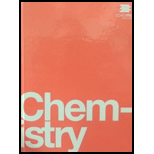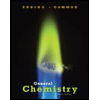
Chemistry by OpenStax (2015-05-04)
1st Edition
ISBN: 9781938168390
Author: Klaus Theopold, Richard H Langley, Paul Flowers, William R. Robinson, Mark Blaser
Publisher: OpenStax
expand_more
expand_more
format_list_bulleted
Textbook Question
Chapter 16, Problem 30E
What is the difference between △G, △G, and △G °298 for a chemical Change?
Expert Solution & Answer
Trending nowThis is a popular solution!

Students have asked these similar questions
draw the major product formed with the listed reagents
Propose Williamson ether syntheses for the following compounds
Identify all functional groups
Chapter 16 Solutions
Chemistry by OpenStax (2015-05-04)
Ch. 16 - What is a spontaneous reaction?Ch. 16 - What is a nonspontaneous reaction?Ch. 16 - Indicate whether the following processes are...Ch. 16 - A helium-filled balloon spontaneously deflates...Ch. 16 - Many plastic materials are organic polymers that...Ch. 16 - In Figure 16.8 all possible distributions and...Ch. 16 - In Figure 16.8 all of the possible distributions...Ch. 16 - How does the process described in the previous...Ch. 16 - Consider a system similar to the one in Figure...Ch. 16 - Consider the system shown in Figure 16.9. What is...
Ch. 16 - Consider the system shown in Figure 16.9. What is...Ch. 16 - Arrange the following sets of systems in order of...Ch. 16 - At room temperature, the entropy of the halogens...Ch. 16 - Consider two processes: sublimation of I2(s) and...Ch. 16 - Indicate which substance in the given pairs has...Ch. 16 - Predict the sign of the entropy change for the...Ch. 16 - Predict the sign of the entropy change for the...Ch. 16 - Write the balanced chemical equation for the...Ch. 16 - Write the balanced chemical equation for the...Ch. 16 - What is the difference between S, S , and S 298...Ch. 16 - Calculate S298 for the following changes. (a)...Ch. 16 - Determine the entropy change for the combustion of...Ch. 16 - Determine the entropy change for the combustion of...Ch. 16 - Thermite reactions have been used for welding...Ch. 16 - Using the relevant S 298 values listed in Appendix...Ch. 16 - From the following information, determine S298 for...Ch. 16 - By calculating Suniv, at each temperature,...Ch. 16 - Use the standard entropy data in Appendix G to...Ch. 16 - Use the standard entropy data in Appendix G to...Ch. 16 - What is the difference between G, G, and G 298 for...Ch. 16 - A reaction has H298=100 kj/mol and S298=250 J/mol ...Ch. 16 - Explain what happens as a reaction starts with G0...Ch. 16 - Use the standard free energy of formation data in...Ch. 16 - Use the standard free energy data in Appendix G to...Ch. 16 - Given: P4(s)+5O2(g)P4O10(s)G298=2697.0kJ/mol...Ch. 16 - Is the formation of ozone (O3(g)) from oxygen...Ch. 16 - Consider the decomposition of red mercury(II)...Ch. 16 - Among other things, an ideal fuel for the control...Ch. 16 - Calculate G for each of the following reactions...Ch. 16 - Calculate G for each of the following reactions...Ch. 16 - Calculate the equilibrium constant at 25 C for...Ch. 16 - Calculate the equilibrium constant at 25 C for...Ch. 16 - Calculate the equilibrium constant temperature...Ch. 16 - Calculate the equilibrium constant temperature...Ch. 16 - Consider the following reaction at 298 K:...Ch. 16 - Determine the normal boiling point (in kelvin) of...Ch. 16 - Under what conditions is N2O3(g)NO(g)+NO2(g)...Ch. 16 - At mom temperature, the equilibrium constant (Kw)...Ch. 16 - Hydrogen sulfide is a pollutant found in natural...Ch. 16 - Consider the decomposition of CaCO3(s) into CaO(s)...Ch. 16 - In the laboratory, hydrogen chloride (HCl(g)) and...Ch. 16 - Benzene can be prepared from acetylene....Ch. 16 - Carbon dioxide decomposes into CO and O2 at...Ch. 16 - Carbon tetrachloride, an important industrial...Ch. 16 - Acetic acid, CH3CO2H, can form a dimer,...Ch. 16 - Nitric acid, HNO3, can be prepared by the...Ch. 16 - Determine G for the following reactions. (a)...Ch. 16 - Given that the Gf for Pb2+(aq) and Cl-(aq) is...Ch. 16 - Determine the standard free energy change, Gf, for...Ch. 16 - Determine the standard enthalpy change, entropy...Ch. 16 - The evaporation of one mole of water at 298 K has...Ch. 16 - In glycolysis, the reaction of glucose (Glu) to...Ch. 16 - One of the important reactions in the biochemical...Ch. 16 - Without doing a numerical calculation, determine...Ch. 16 - When ammonium chloride is added to water and...Ch. 16 - An important source of copper is from the copper...Ch. 16 - What happens to G (becomes more negative or more...
Additional Science Textbook Solutions
Find more solutions based on key concepts
Your bore cells, muscle cells, and skin cells look different because a. different kinds of genes are present in...
Campbell Essential Biology (7th Edition)
For the following fragment of DNA, determine the number of hydrogen bonds and the number of phosphodiester bond...
Genetic Analysis: An Integrated Approach (3rd Edition)
8. A 1000 kg car pushes a 2000 kg truck that has a dead battery. When the driver steps on the accelerator, the ...
Physics for Scientists and Engineers: A Strategic Approach, Vol. 1 (Chs 1-21) (4th Edition)
For the generic equilibrium HA(aq) ⇌ H + (aq) + A- (aq), which of these statements is true?
The equilibrium con...
Chemistry: The Central Science (14th Edition)
Police Captain Jeffers has suffered a myocardial infarction. a. Explain to his (nonmedically oriented) family w...
Human Physiology: An Integrated Approach (8th Edition)
What are the four types of tissues, and what are their characteristics?
Human Anatomy & Physiology (2nd Edition)
Knowledge Booster
Learn more about
Need a deep-dive on the concept behind this application? Look no further. Learn more about this topic, chemistry and related others by exploring similar questions and additional content below.Similar questions
- A mixture of CaCO3 and MgC2O4 of unknown mass was heated in a 0.5 L closed rigid vessel to 900 degrees C.at 400C the following reaction occurs:MgC2O4 -> MgO (s) + CO (g) + CO2 (g)At 700C a second reaction occurs: CaCO3 -> CaO (s) + CO2 (g)The solid mass in the vessel was measured to be 3.06 g at 400C and 2.03g at 900CQuestion: What is the partial pressure of CO in both temperatures? (400 and 900C), provide detailed explanation.arrow_forwardFor the following alkyne, complete the reaction sequentially (that is draw the intermediate that we can’t stop at) and then name (complete name) all 3 molecules.arrow_forwardGiven the reaction sequence below, answer the following. A. Provide the structure for A. B. Provide the structure for B (pay attention to stereochemistry). C. Provide the structure for C. D. What are the stereochemical designations for I and II (R/S)?arrow_forward
- There are 2 reactions (that you know of) to achieve the following transformation: One reaction is favored over the other because it avoids a competing reaction. A. Draw the favored reaction scheme (not the mechanism), be sure to include all necessary reagents. B. Draw the reaction scheme that is not favored and include all the possible products.arrow_forwardBoth carbocations and carbon-radicals have trigonal planar geometry. True or Falsearrow_forwardTeflon (polytetrafluoroethene) is prepared via the radial polymerization of tetrafluoroethene. What other reaction conditions (reagent, etc.) are needed to accomplish this? A. NBS, Light B. Heat, Cl2 C. Peroxide, Heat D. H2SO4, H2O, Heatarrow_forward
- Which of the following compounds can be reacted with ethene to prepare 1,1- dichlorocyclopropane? A. CCl4 B. CCl2 C. CHCl3 D. CH2Cl2arrow_forwardusing any reactions, starting with propene, propose a synthesis for the following moleculearrow_forwardFor a free radical bromination reaction, the stereochemistry of the product is easily controlled True OR Falsearrow_forward
arrow_back_ios
SEE MORE QUESTIONS
arrow_forward_ios
Recommended textbooks for you
 General Chemistry - Standalone book (MindTap Cour...ChemistryISBN:9781305580343Author:Steven D. Gammon, Ebbing, Darrell Ebbing, Steven D., Darrell; Gammon, Darrell Ebbing; Steven D. Gammon, Darrell D.; Gammon, Ebbing; Steven D. Gammon; DarrellPublisher:Cengage Learning
General Chemistry - Standalone book (MindTap Cour...ChemistryISBN:9781305580343Author:Steven D. Gammon, Ebbing, Darrell Ebbing, Steven D., Darrell; Gammon, Darrell Ebbing; Steven D. Gammon, Darrell D.; Gammon, Ebbing; Steven D. Gammon; DarrellPublisher:Cengage Learning Chemistry for Today: General, Organic, and Bioche...ChemistryISBN:9781305960060Author:Spencer L. Seager, Michael R. Slabaugh, Maren S. HansenPublisher:Cengage Learning
Chemistry for Today: General, Organic, and Bioche...ChemistryISBN:9781305960060Author:Spencer L. Seager, Michael R. Slabaugh, Maren S. HansenPublisher:Cengage Learning Chemistry: Principles and PracticeChemistryISBN:9780534420123Author:Daniel L. Reger, Scott R. Goode, David W. Ball, Edward MercerPublisher:Cengage Learning
Chemistry: Principles and PracticeChemistryISBN:9780534420123Author:Daniel L. Reger, Scott R. Goode, David W. Ball, Edward MercerPublisher:Cengage Learning Chemistry for Engineering StudentsChemistryISBN:9781337398909Author:Lawrence S. Brown, Tom HolmePublisher:Cengage LearningChemistry: Matter and ChangeChemistryISBN:9780078746376Author:Dinah Zike, Laurel Dingrando, Nicholas Hainen, Cheryl WistromPublisher:Glencoe/McGraw-Hill School Pub Co
Chemistry for Engineering StudentsChemistryISBN:9781337398909Author:Lawrence S. Brown, Tom HolmePublisher:Cengage LearningChemistry: Matter and ChangeChemistryISBN:9780078746376Author:Dinah Zike, Laurel Dingrando, Nicholas Hainen, Cheryl WistromPublisher:Glencoe/McGraw-Hill School Pub Co Introductory Chemistry: A FoundationChemistryISBN:9781337399425Author:Steven S. Zumdahl, Donald J. DeCostePublisher:Cengage Learning
Introductory Chemistry: A FoundationChemistryISBN:9781337399425Author:Steven S. Zumdahl, Donald J. DeCostePublisher:Cengage Learning

General Chemistry - Standalone book (MindTap Cour...
Chemistry
ISBN:9781305580343
Author:Steven D. Gammon, Ebbing, Darrell Ebbing, Steven D., Darrell; Gammon, Darrell Ebbing; Steven D. Gammon, Darrell D.; Gammon, Ebbing; Steven D. Gammon; Darrell
Publisher:Cengage Learning

Chemistry for Today: General, Organic, and Bioche...
Chemistry
ISBN:9781305960060
Author:Spencer L. Seager, Michael R. Slabaugh, Maren S. Hansen
Publisher:Cengage Learning

Chemistry: Principles and Practice
Chemistry
ISBN:9780534420123
Author:Daniel L. Reger, Scott R. Goode, David W. Ball, Edward Mercer
Publisher:Cengage Learning

Chemistry for Engineering Students
Chemistry
ISBN:9781337398909
Author:Lawrence S. Brown, Tom Holme
Publisher:Cengage Learning

Chemistry: Matter and Change
Chemistry
ISBN:9780078746376
Author:Dinah Zike, Laurel Dingrando, Nicholas Hainen, Cheryl Wistrom
Publisher:Glencoe/McGraw-Hill School Pub Co

Introductory Chemistry: A Foundation
Chemistry
ISBN:9781337399425
Author:Steven S. Zumdahl, Donald J. DeCoste
Publisher:Cengage Learning
The Laws of Thermodynamics, Entropy, and Gibbs Free Energy; Author: Professor Dave Explains;https://www.youtube.com/watch?v=8N1BxHgsoOw;License: Standard YouTube License, CC-BY